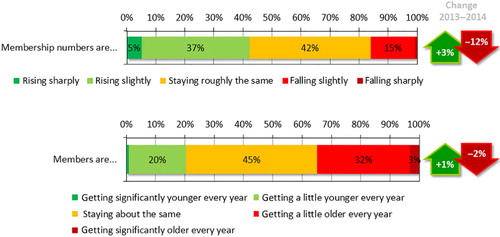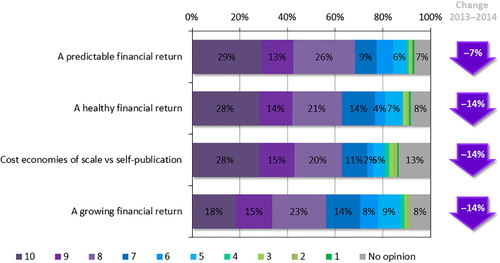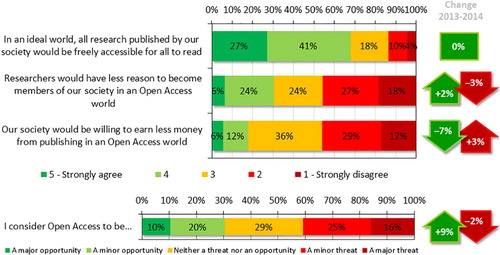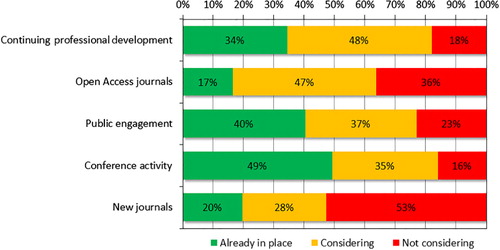Life is still tough for many learned societies, but green shoots of optimism are appearing. In particular, attitudes to Open Access are changing, with learned societies starting to view Open Access as a business opportunity to engage with as much as a means of increasing outreach.
What we did
ALPSP and Taylor & Francis conducted a survey of learned society officers in April 2014, following up a similar survey from 2013. The findings of the 2014 survey are summarised in the companion article “2014 Taylor & Francis and ALPSP society survey: challenges facing learned societies”.Citation1 The sample size (139 responses, a 7% response rate) means this is a snapshot of how society officers feel today, but comparing results from the two years provides intriguing insight into the mood and priorities of leading figures in the community today.
Membership and financial matters
Societies are finally moving past the recession and beginning to feel greater confidence about the future. More than twice as many report that member numbers are rising rather than falling (42% say numbers are rising sharply or rising slightly, 16% report a fall), where last year nearly 3 out of 10 were experiencing decline. Memberships are still ageing on balance, but there is little change from 2013. shows these results graphically.
More than one-third of societies in our survey (35%) say that income from journal publishing is up, and half (51%) have flat financial performance (see ). Similar patterns appear in learned society returns from all activities, with constant financial performance far and away the most common experience (53% of respondents). Fewer societies reported flat financial performance than in 2013. A small minority of learned societies (15%) say that there return from journal publishing has declined.
Many societies appear to be content with steady financial performance. Two-thirds say that they strongly value a predictable financial return (68%), rating this above a “healthy” or “growing” return (see ). In 2013, “healthy” scored highest. In turbulent times, societies desire an absence of financial surprises above all else.
The “new pragmatism” about Open Access
Perhaps the most striking manifestation of greater self-assurance comes in the field of Open Access. A large majority of respondents (68%) believe that research published by their society should be free to read for all. Intriguingly, this is exactly the same proportion as last year (see ). Learned societies’ underlying attitudes to Open Access appear to be constant. Similar if less emphatic positivity has been reported in other recent surveys, including those by WileyCitation2 and EDP Sciences.Citation3
What is different is views on the financial consequences of Open Access for learned societies. Many fewer of our respondents are prepared to lose money making Open Access happen. Only 18% of societies say that they are willing to earn less money in an Open Access world, against 46% who are not. This is a 10% swing away from the “earn less” position compared to the 2013 survey.
Anxiety remains that Open Access reduces the appeal of society membership. Close to half our respondents (45%) agree that Open Access gives members less reason to belong to societies, versus 30% who disagree. The gap is smaller than last year (a 20 percentage point differential is now 15 points), but this issue clearly troubles many learned society officers.
The biggest difference of all comes in whether Open Access is viewed as opportunity or threat. Almost one-third of respondents (30%) now see Open Access as an opportunity, compared to 41% who see it as a threat. Whilst “threat” is still the larger number, the difference between these two camps is half that reported in 2013.
What have we learnt?
Is this the start of a “new pragmatism” for societies about Open Access? Certainly, fear seems to be giving way to a sense of practical opportunity. Looking ahead, nearly half of respondents (47%) say they are planning new Open Access journals (see ).
If Open Access is the new rock ‘n’ roll, it seems that learned societies are looking for a little less conversation, and a little more action.
Additional information
Notes on contributors

Rod Cookson
Rod Cookson is Editorial Director for Medicine and Health Science journals at Taylor & Francis. He was previously Editorial Director for Earth, Biological and Environmental Science journals, and before that Publisher for our Geography Journal programme. Rod joined Taylor & Francis ten years ago, after working for four years at Blackwell Publishing. Prior to that, Rod set up and ran a book packaging and publishing company for two years, worked in educational book publishing for three years and was a bookseller for three years.
References
- Frass W. 2014 Taylor & Francis and ALPSP society survey: challenges facing learned societies. Editors' Bulletin. 2014.
- Meadows A. What societies really think about Open Access. Scholarly Kitchen. 2014 [cited 2014 October 2]. Available from: http://scholarlykitchen.sspnet.org/2014/06/25/what-societies-really-think-about-open-access
- TBI Communications. Learned Society attitudes towards Open Access. 2014 [cited 2014 October 2]. Available from: http://www.edp-open.org/images/stories/doc/EDP_Society_Survey_May_2014_FINAL.pdf






